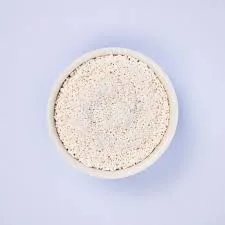
dimethyl disulfide dmds
Dimethyl Disulfide (DMDS) A Comprehensive Overview
Dimethyl disulfide (DMDS) is an organic compound with the molecular formula C2H6S2. It is characterized by its pungent odor, often reminiscent of rotten cabbage or garlic, making it a compound that readily captures attention in both industrial and laboratory settings. DMDS plays a pivotal role in various fields, including agriculture, chemical synthesis, and environmental science.
Chemical Structure and Properties
DMDS consists of two methyl groups (–CH3) attached to a disulfide bridge (–S–S–). This chemical configuration renders it a member of the class known as disulfides. As a colorless liquid at room temperature, it has a boiling point of approximately 162 °C. Its density is slightly lower than that of water, making it less dense but more viscous. DMDS is soluble in organic solvents such as ethanol and ether, although it is insoluble in water.
Applications in Agriculture
One of the most significant applications of DMDS is in the agricultural sector. It serves as a powerful fumigant and soil treatment agent. Farmers and agricultural scientists use DMDS to control soil-borne pathogens and pests, including nematodes and fungi that can harm crops. The compound’s efficacy as a biocide is attributed to its ability to penetrate the soil and release sulfide ions, which are toxic to various microorganisms.
In addition to its role in pest management, DMDS promotes healthier soil conditions by enhancing microbial activity. This improves soil fertility and crop yield, making DMDS a valuable asset for sustainable farming practices. Its application aligns with the growing demand for environmentally friendly agricultural solutions, as it is considered less harmful than many traditional chemical pesticides.
Industrial Uses
Beyond agriculture, DMDS has several industrial applications. It is utilized in the production of various chemicals, including sulfur-containing compounds and plasticizers. DMDS serves as a precursor for the synthesis of other organic compounds, acting as a reagent in numerous chemical reactions. For instance, it is employed in the manufacture of pesticides, herbicides, and pharmaceuticals.
dimethyl disulfide dmds

Moreover, DMDS has also found niche applications in the oil and gas industry. It is sometimes added to crude oil to enhance the efficiency of extraction processes and to mitigate the formation of scale and corrosion in pipelines.
Environmental Considerations
While DMDS is beneficial in many applications, it is essential to recognize its environmental implications. The compound is volatile and can contribute to air pollution when released into the atmosphere. In addition, its strong odor can be a nuisance to nearby communities. Therefore, careful handling and application are crucial to minimizing its environmental impact.
Research is ongoing to develop methods to mitigate the release of volatile organic compounds (VOCs) like DMDS during industrial processes. Advances in filtration technology and regulations on emissions are critical in ensuring that the benefits of DMDS do not come at an unacceptable environmental cost.
Safety and Handling
Given its pungent odor and potential irritative effects, DMDS should be handled with caution. It can cause respiratory irritation, and prolonged exposure may lead to more severe health effects. As such, it is imperative to use proper protective equipment, including gloves and masks, when handling DMDS in both laboratory and industrial environments.
Conclusion
In summary, dimethyl disulfide is a versatile compound with significant applications in agriculture, industry, and chemical synthesis. Its unique properties allow it to serve as an effective fumigant and a reagent in various chemical processes. However, with its benefits come responsibilities—careful handling and a commitment to minimizing environmental impacts are essential for sustainable use. As scientists continue to explore the potential of DMDS and develop safer application methods, its role in modern practices is likely to expand further, highlighting the dynamic nature of chemical compounds in our society.
-
The Safety Challenges of Ammonium Nitrate FertilizerNewsJun.26,2025
-
The Critical Role of Mining ChemicalsNewsJun.26,2025
-
Shelf Life of Glacial Acetic Acid Food GradeNewsJun.26,2025
-
Enhancing PVC Longevity with 1,2,3-Benzotriazole InnovationsNewsJun.26,2025
-
China’s Dominance in Food Additive ProductionNewsJun.26,2025
-
Can Aluminum Hydroxide Replace More Toxic Alternatives?NewsJun.26,2025
-
PE and PP Plastics with Benzotriazole AdditivesNewsJun.12,2025
Hebei Tenger Chemical Technology Co., Ltd. focuses on the chemical industry and is committed to the export service of chemical raw materials.
-

view more DiethanolisopropanolamineIn the ever-growing field of chemical solutions, diethanolisopropanolamine (DEIPA) stands out as a versatile and important compound. Due to its unique chemical structure and properties, DEIPA is of interest to various industries including construction, personal care, and agriculture. -

view more TriisopropanolamineTriisopropanolamine (TIPA) alkanol amine substance, is a kind of alcohol amine compound with amino and alcohol hydroxyl, and because of its molecules contains both amino and hydroxyl. -

view more Tetramethyl Thiuram DisulfideTetramethyl thiuram disulfide, also known as TMTD, is a white to light-yellow powder with a distinct sulfur-like odor. It is soluble in organic solvents such as benzene, acetone, and ethyl acetate, making it highly versatile for use in different formulations. TMTD is known for its excellent vulcanization acceleration properties, which makes it a key ingredient in the production of rubber products. Additionally, it acts as an effective fungicide and bactericide, making it valuable in agricultural applications. Its high purity and stability ensure consistent performance, making it a preferred choice for manufacturers across various industries.











